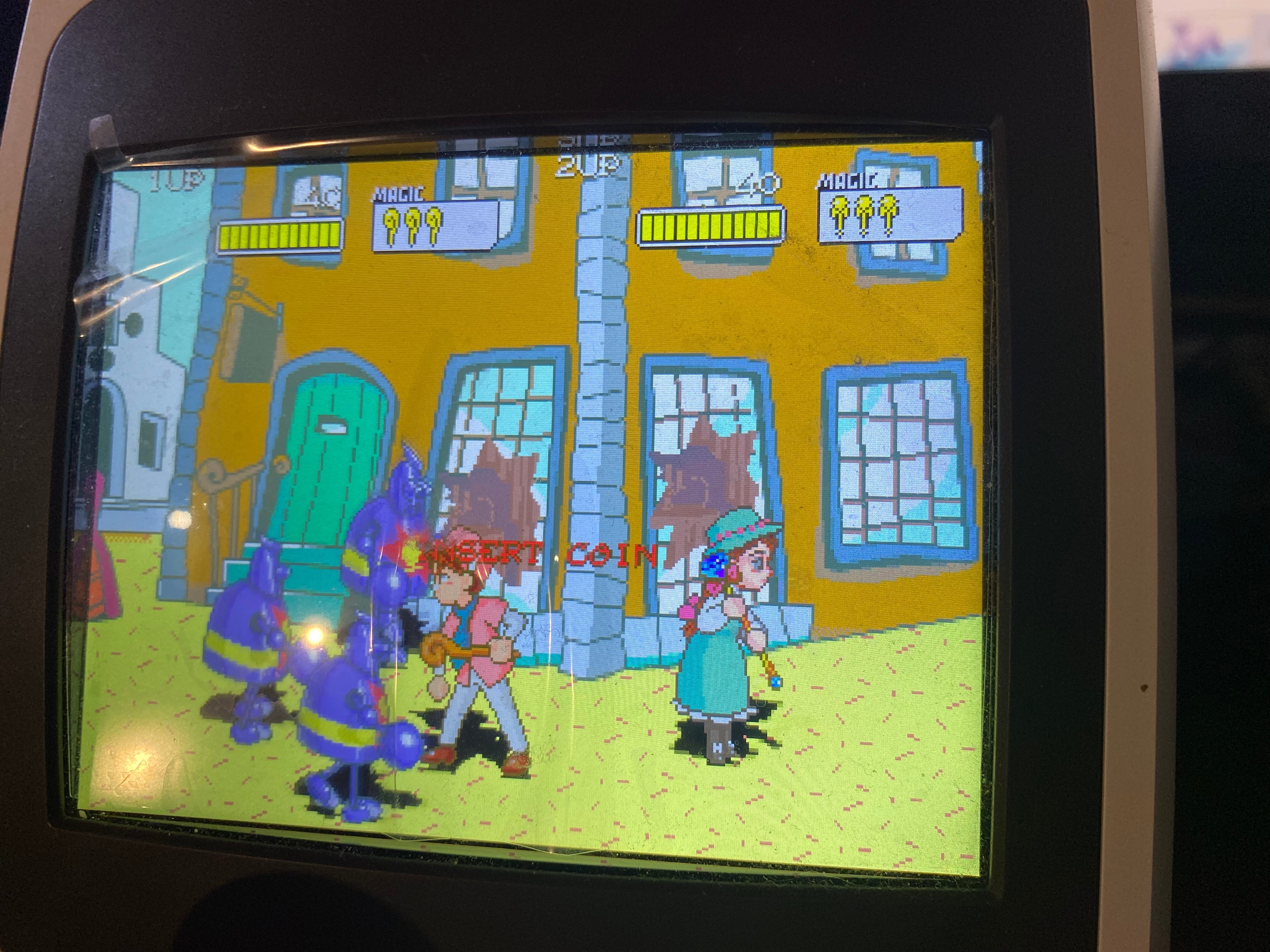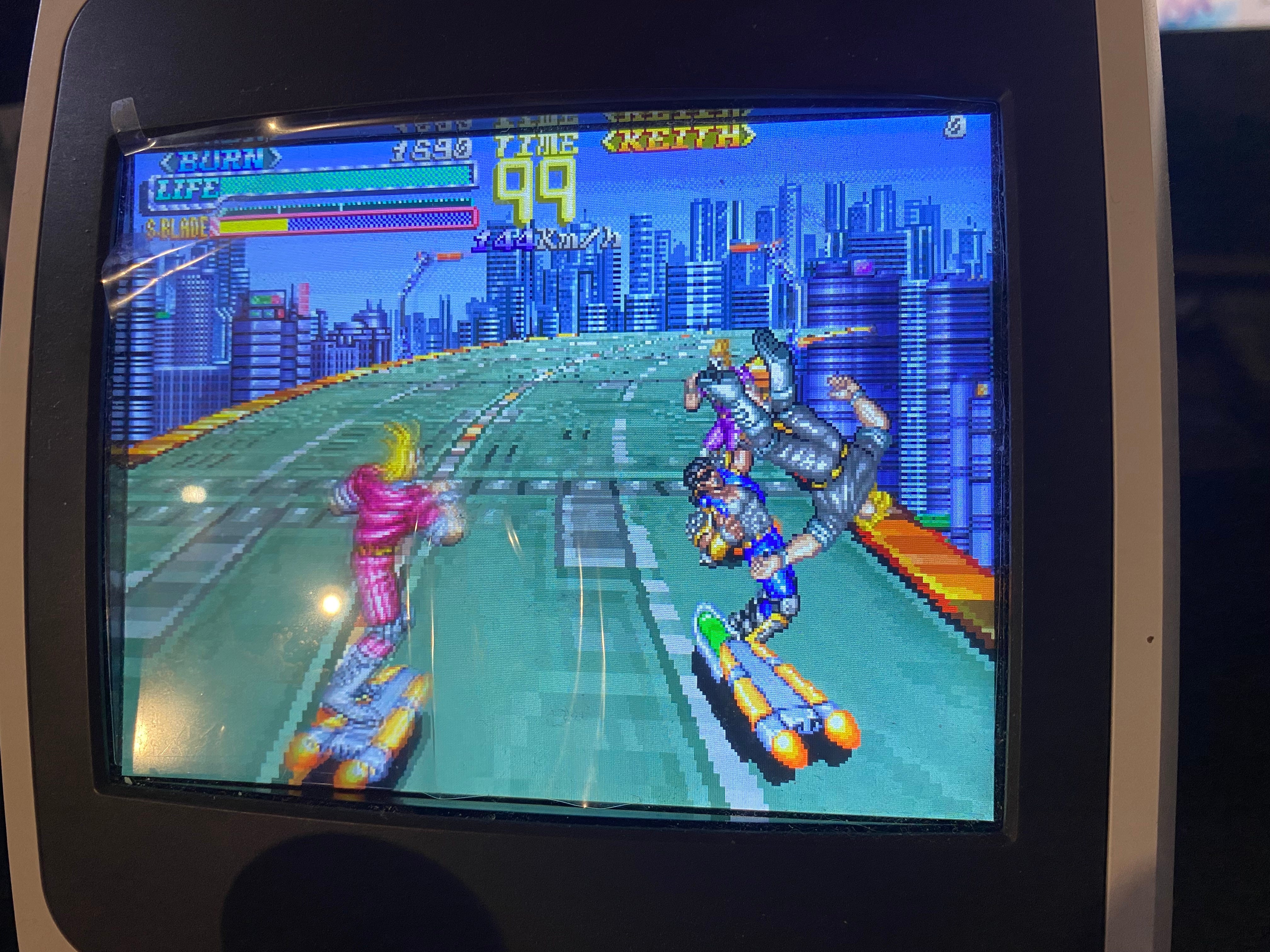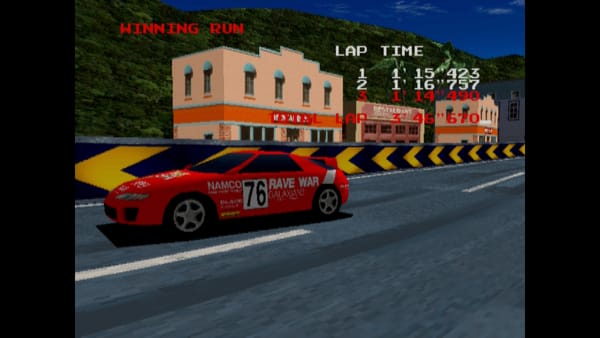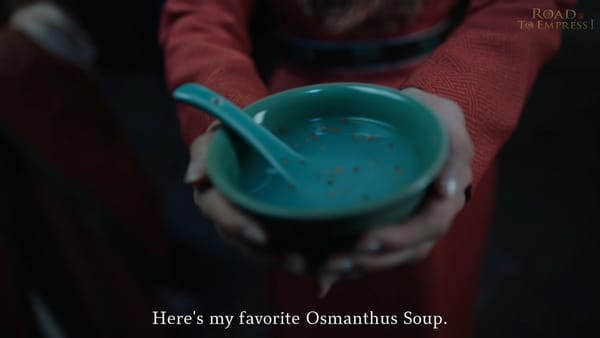Taito Arcade Memories Vol. 1 gives the Egret Mini II 10 more Taito games, almost all of which are good
And the ones that aren't good are interesting, which is as good as being good.

It speaks to Taito’s sheer passion for the novelty, luxury Egret II Mini project (my review, 1 and 2) that they’ve continued to support it after release. The toy arcade cabinet wants not just to stand on your shelf, but to really be used and loved alongside your more sophisticated machines. A firmware update added some features a few months back, and today I’m looking at the mini-system’s first real game expansion card.1
It remains to be seen whether Taito will continue to supply new old games for its little arcade machine, but they’ve certainly chosen a strong selection this time. Arcade Memories Vol. 1 has some experimental beat-em-ups and a loosely related string of vertical shooters by Taito and Toaplan.
I’ll be using Japanese titles because English versions are not present on this collection. I always consider this an oversight, especially for games of this vintage; it was pretty common for games to have big changes between regions, for better and worse.
And I must note, because I understand that not everybody is picking up $80 expansions for $200 toy mini arcade cabinets, some of these games are available in the Arcade Archives series and all of them are available in emulation if you know where to look. Whichever route you want to take, you can easily play any of these games.2
Packaging

Every part of the Egret II Mini has been luxuriously packed, and this even goes for a single SD-card expansion. The card comes in a Switch-sized game box, packed in a larger cardboard box with another Taito Station magazine— much smaller, a 32-page pamphlet versus the behemoth that came with the original unit— packed inside.
Thoughtfully, there are ten miniature marquee cards to place atop your Egret II Mini, one for each game. I’m probably never dropping Kiki Kaikai from mine, but the dedication to completeness here is admirable.
The caveat is that like the previous system, international shipping costs were rough. I paid about $80 shipped for this expansion on sale. Nothing about the Egret II Mini has been cheap; after all, the real thing is $3000+ these days.
Issues
There are four vertical shooters on this game list, and the developers have still not fixed the Mini’s auto-fire problem. The Mini has one auto-fire speed setting, and it’s the maximum input speed the game can handle, which is well past human ability. As such, playing certain games on the Mini with the auto-fire button is basically cheating: a machine gun with an infinite rate of fire that kills bosses instantly.3 On the other hand, unless you want to give yourself carpal tunnel syndrome I strongly suggest you not play some of these older games “as intended” with constant painful button-mashing.
For this reason, most retro ports of shooters, not to mention every emulator, have adjustable auto fire rates that simulate a reasonably fast player’s button speed without breaking the game or your wrists. The Egret II Mini, after a firmware update, still doesn’t.
C’mon Taito guys, let’s get this fixed! Medium-speed autofire, please!
Game list
Taito’s “name” titles like the Bubble Bobble and Elevator Action series are already on the base Egret unit, and they didn’t hold much back the first time. This is a release for retro fans who are interested in really digging into the library, and not even necessarily Taito games. This small collection of ten games is filled out half with oddities and experiments and half with traditional shooter red meat for hardcore retro fans, mostly from genre fan favorite Toaplan.
Pu-Li-Ru-La

The standout game on this list that I would show anybody is Taito’s surrealist cartoon beat-em-up Pu-Li-Ru-La. Roughly contemporaneous with Konami’s Simpsons game, I can imagine these two standing next to each other in the arcade. Loud, vivid colors, beautiful animation, and simple, no-frills gameplay. Simple thrill ride quarter-munchers.
What distinguishes Pu-Li-Ru-La is its nonstop, truly surreal visuals. It’s clear that given new hardware capable of more advanced visuals, Taito’s artists decided to just go as weird as possible. In the game’s most memorable scene, players walk through a town as an enormous pair of high-heeled legs thrust through the doors of two of the houses to attack. The digitized images of actual Taito employees also appear throughout.
The aesthetic is proudly incoherent and probably three decades ahead of its time; today the kids would call it a “shitpost” game. You gotta play it. It’s short, so make sure you get all the way to the end. You don’t want to miss the story for this one.
Great Swordsman/Ougon no Shiro (Gladiator)
A duology of odd sword-fighting simulators from Seta/Allumer. Both of these games are concerned not just with hacking and slashing but precision swordplay, with control systems that allow players to directly aim their blades and guard against incoming attacks. Great Swordsman simulates a tournament experience similar to Karate Champ, switching from modern fencing to traditional kendo to ancient Roman gladiatorial combat.
Which brings us to the second game, which runs with the gladiator motif. Ougon no Shiro (aka Gladiator) is a weird side-scroller that throws some snakes, arrows, and fireballs for players to deal with between pokey, stabby duels with similarly-equipped opponents.
You have to package these games together because they’re so clearly directly related. They’re kind of janky and brutally hard, sure, but it’s fascinating to play them in order and see how the ideas behind one mutated into the other.4
Cleopatra Fortune
Non-standard falling-block puzzle games don’t really have a shot, right? If it’s not making lines ala Tetris or matching colors ala everything else, your concept just won’t stick in people’s heads. So it is with Cleopatra Fortune, a game which appears inscrutable at first glance but is actually quite intuitive and fun if you’re not thinking in terms of matching types.
In Cleopatra Fortune, blocks and treasures fall from the sky. Though you can line them up by type, the main mechanic is actually to “entomb” the treasures by clumping them all together and then fully enclosing the treasure hoard with blocks. A greed versus caution situation ensues as you try to pack together a massive clump of treasure while leaving some room to enclose it. Blocks come down fast, and it’s easy to lose control of the pile when a few of them drop in the wrong place.
Also— though this might be redundant when it comes to Taito games and their in-house sound team Zuntata— the game has an absolutely killer soundtrack with an earworm of a theme song.
Daisenpuu (Twin Hawk)
Part of Toaplan’s wave of 80s classics, this game reconsiders the whole concept of the “bomb” in shooting games. Rather than a screen-clearing attack for when you’re in trouble, in Daisenpuu the bomb button summons a formation of allied planes who multiply your fire. The downside is that they can be shot down, just like you.
So you can choose to use your formation to crush the early stages and blow up everything before it even has the chance to fire. But as enemies get stronger and there are more bullets on the screen, your trump card gets less and less useful. A clever way of scaling beginner to expert difficulty from Toaplan, known largely for merciless games like Truxton/Tatsujin (“Expert”, appropriately enough).
Light Bringer (Dungeons And Magic)
Reminiscent of Capcom’s classic Dungeons and Dragons arcade games, Light Bringer brings old-school (even at the time) RPG dungeon-crawling flavor to the standard beat-em-up. Rather than straightforward “belt scrolling” stages, players navigate a dungeon with many different ways to make it to the end.
True to its premise, there’s a lot more going on in Light Bringer than you’d expect from a random mid-90s beat-em-up. Starting out with pretty low HP, you really need to loot every room for high-scoring loot: your score functions the same as experience points in an RPG, and you will level up at certain point thresholds. You’ll also find weapons that change your charge attack: rather than upgrading raw statistics, the use of these weapons depends more on your situation.
So this game really boils down to hacking through every box and treasure chest you can find in hopes of eventually leveling. But there’s a strict two-minute time limit for every room, and monsters attack if you even take half that much time, so it’s never worth it to completely loot a place. And even if you could, in classic dungeon crawl tradition many of the really good treasures are trapped: opening them from point blank range will freeze, poison or electrocute you. So you don’t just get the raw action of a beat-em-up, but the strategy and short-term advancement of an RPG in miniature.
But Light Bringer has a pretty major weakness, and unfortunately it’s the clunky combat. It’s quite difficult to line up your characters’ weak, slow, stubby attacks in the game’s unique 3/4th overhead view. Even more than other beat-em-ups, it really doesn’t feel like you have a chance if enemies close in. The non-sword-dude characters (elf and mage) are so weak that it really feels like they’re meant exclusively to play a support role in 2-player mode. If the combat was tightened up just a little bit I’d call Light Bringer a secret classic. As it is, it’s still pretty cool.
Please be aware that the ninja character is not Guts from Berserk. He’s clearly Gara the ninja from Bastard!!. Get it together, guys.
Slap Fight
Slap Fight rules. I’ve probably talked about this game around the time I reviewed the first Mega Drive Mini, and I sure don’t mind talking about it again.
Inspired no doubt by Gradius’ customizable “bar” upgrade system, Slap Fight puts a whole other spin on it. Rather than building “option” buddies that follow you around and fire the same weapons as you, Slap Fight allows you to upgrade with “power wings” that slap right onto the sides of the ship. You can add up to three wing expansions, making your ship the size of the screen, able to blow up anything but also a massive target.
About twelve minutes long in its entirety, the game is a balancing act between your own greed for more firepower and the danger of constant enemy fire. This is the kind of game where the enemies shoot directly at you, so staying alive as the big ship requires some really fancy footwork.
Great game, and I strongly recommend the enhanced and expanded Mega Drive port.
Riding Fight

I didn’t know this one existed until I saw an excerpt on retro gaming Twitter, and I was pretty wowed. It feels like a game people should know about, or maybe it’s just laser targeted at me.
This is a beat-em-up on hoverboards, in the style of Space Harrier. The “driving” is effectively on rails: players get to dodge and smash obstacles while also fighting enemies. The aesthetic is 80s cyberpunk Fist of the North Star (so it’s Cyber Blue?); all cool dudes in sunglasses and fancy shoulder armor. The characters’ names are BURN and KEITH.
For you aficionados of the faux-3D “Super Scaler” genre, this is definitely one to check out. It’s got surprises beyond the initial setup with some really fun level designs and wild bosses. My favorite is the ice level, which builds up to the logical extreme of a hockey plyer boss slap-shotting icicles at you.
Grid Seeker: Project Storm Hammer
A shooter for Taito’s F3 system— which would be at that time brand new— with some very impressive pseudo-3D graphics for 1992. The game likes to show off its illusion of depth by flying you over canyons.
This game also re-imagines the bomb: ships have a bullet absorber at their very tips that allows them to “eat” a lot of enemy fire to build up power to fire off a bomb. Types of bombs vary by what weapon you’re currently equipped with.
This is a very lenient system and you’ll quickly find you have more bomb energy than you know what to do with; unlike many shooters, this game wants you to put those bombs to use. Ideally, fill up your meter, drop a bomb, fill it up again, and repeat. Shooter beginners will need all those bombs, because this is one of those games where you have to repeat the whole level after a continue. No credit-feeding allowed if you want to beat it… which is why I haven’t.
I get the feeling that aside from Slap Fight, there are relationships between the shooters in this collection. This game has the helper mechanic from Daisenpuu, and in Gekirindan you time travel back to 1999— the year this game takes place— and play a level that looks a lot like Grid Seeker. Hmm.
Gekirindan
This is labeled as a Taito game, but it was basically made by Toaplan staff after the dissolution of the latter company. I wasn’t aware of the extent of the Taito-Toaplan connection— they published many of Toaplan’s early classics like Slap Fight and Twin Cobra— until I started doing the research on Gekirindan for this piece. This is effectively a Taito/Toaplan game!
Billed as a “time travel shooting game”, Gekirindan unfortunately doesn’t do much with that premise aside from stepping into World War II for one stage. When every stage is future sci-fi, there isn’t much variety in what you’re fighting: just the type of killer machine you’re up against this time. Also featuring a cast of 90s anime heroes that never really come up past the character select screen, Gekirindan has an uneven aesthetic in general.
Also on the F3 system, Gekirindan’s visuals take the style established in Grid Seeker much further, dipping sprites in and out of the foreground and creating some really powerful sense of place. I especially love the mecha-demon hell portrayed in the final level. It’s very Koichi Ohata, I felt.
The core gameplay is very traditionally Toaplan, down to the types of ships and weapons you’ll be using. It’s just Truxton. Once you know Toaplan made this game, everything else in the game is obvious.
Honestly, after playing through this game I was surprised it wasn’t better known, because it’s really quite high quality. Maybe it’s that it only came out in arcades (and Japanese Saturn, so y’know, it’s been $200+ for 20 years). Maybe it’s because it’s hard as nails from the second level, or because it’s not as flashy or full of secrets as its contemporary Dodonpachi. But I had a good time credit-feeding through this one. Give it a look.
Verdict - Crate digging for the adventurous fan

If you already have a Egret II Mini in the first place, this whole article is probably completely unnecessary. But that’s what I do here, right?!
When compared to the base lineup, obviously the shooter choices represent a B-tier— after all, the base unit has Raystorm, Darius Gaiden, Truxton, Twin Cobra. But being B-tier next to Darius Gaiden or Raystorm is still pretty damned strong. I’d think of it more as “If you like Truxton, you’ll probably like Gekirindan too.”
Now the weird stuff, that’s where Taito really shines, and that’s just as true in this collection. Pu-Li-Ru-La is an experience that will stay with you for a long time, and I don’t think there are any other games quite like Riding Fight or Cleopatra Fortune. And if you bought the luxury Taito toy arcade cabinet, I dare say that you might have some taste for the experimental.
So pick up the expansion if you can! If there’s a next one, maybe it’ll be even weirder, somehow.
The card released with the system, with trackball and spinner games, is more of a physical unlock key for games which were already on the base system. A recent patch rendered it irrelevant. ↩
One of the best things about mini-systems is that they’re curated; a rom heap is one thing, but a collection can directly point out titles you might have missed, like say Wrestleball on the Mega Drive Mini. And then anyone can go play them! ↩
Test this on Kiki Kaikai, where you’ll kill the first boss in about three seconds. ↩
Allumer went on to make Blandia, which threw Gurianos into a standard-issue Street Fighter II type game in a similar fantasy setting. Arguably the third in the series, it bears no resemblance at all to its forebears. Unrelated to anything at all— but highly relevant to readers of this blog— Allumer also made Mobile Suit Gundam EX Revue, a direct mashup of the original Mobile Suit Gundam TV series with Street Fighter II.) ↩



